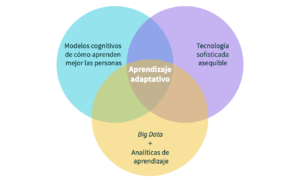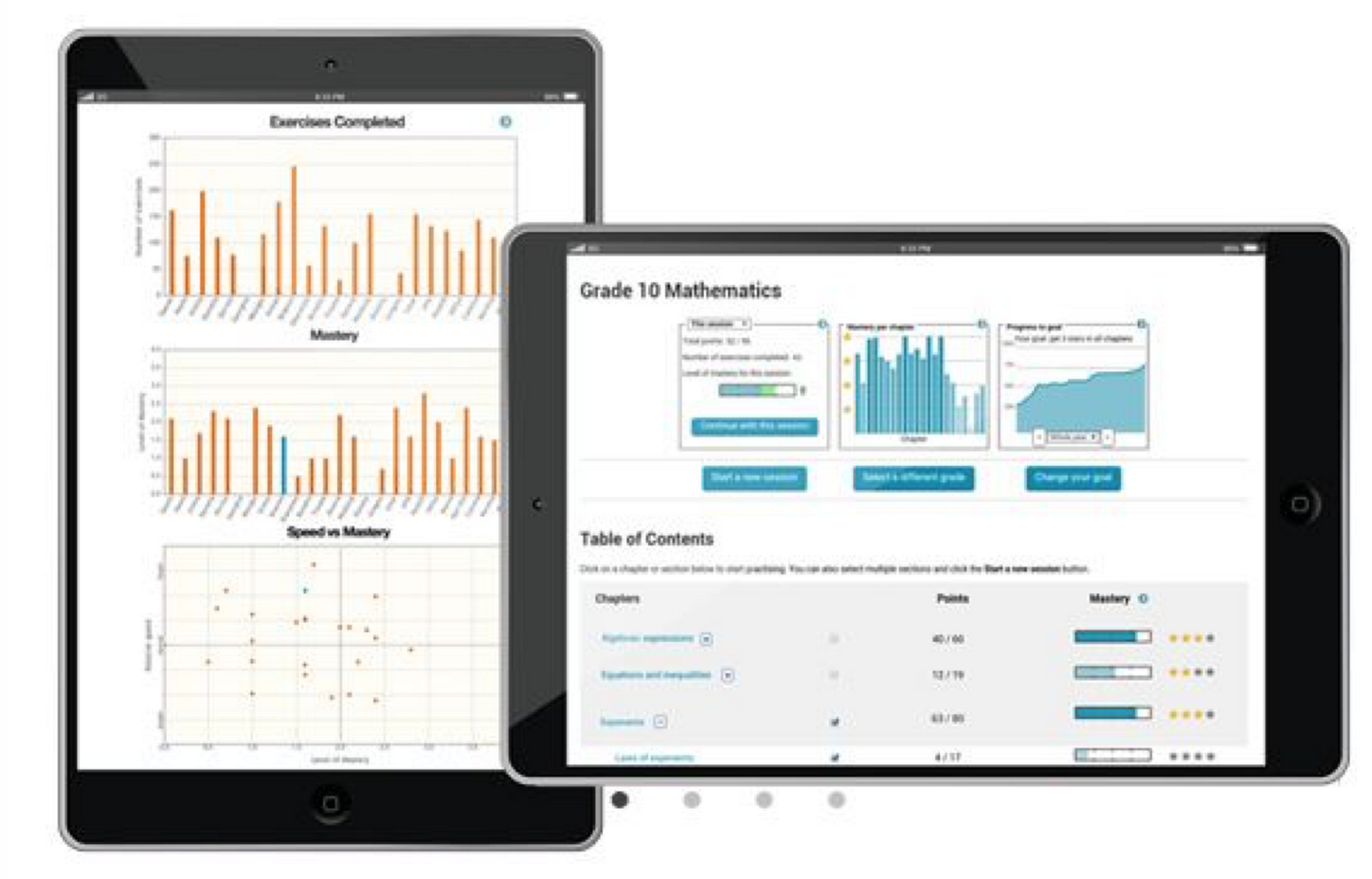What is it?
Although, of course, its universalization has taken place in recent years due to the great development of artificial intelligence and the popularization of new technologies, adaptive learning has its roots in the 1950s and even earlier. Its precursors and bases can be found in:
- The psychologists’ levels and abilities scales Alfred Binet and Théodore Simon, who, commissioned by the French Ministry of Education at the time, designed the first test to measure children’s intelligence, when education had just become universal in their country.
- Burrhus Frederic Skinner’s programmed learning theory and the teaching machine. In 1954 this famous behaviourist developed the paradigm of operant conditioning operant conditioning he design on a “teaching machine” that could promote learning more effectively than traditional educational methods, which he considered highly ineffective. Based on his theory of programmed learning, he designed a teaching machine called Glider. It was a mechanical device that allowed an automatic control of the learning process, because it was strictly planned to follow a linear progression. In this way he developed programmes for teaching spelling, mathematics and other subjects.
- Programmed tutorial systems for intelligent teaching. For example Donald Bitzer’s PLATO system, created in the 1960s, and computer scientist Jaime Carbonell’s Scholar system.
As mentioned before, with the evolution of Information and Communication Technologies, and as computers have become smaller more powerful and less expensive, adaptive learning is now applicable to classroom teaching, distance learning and tutoring scenarios. Moreover, we are at a particularly opportune moment, thanks to the convergence of three elements (Lemke, 2014):
- Access to necessary technology by teachers.
- The availability of sophisticated data and learning analytics.
- Emerging research on how people learn.

Source: Observatorio de Innovación Educativa del Tecnológico de Monterrey.
What are its main advantages?
The advantages of properly applied adaptive learning, are many. Among the main ones, we can highlight the following (Inspiratics and Observatory of Educational Innovation):
- The students are protagonists of their own learning.
- Individualized and real-time feedback.
- Improves instructional design by combining it with a hybrid model.
- Constantly monitors and analyses the student’s performance and progress.
- It frees up class time for challenging activities and high-level discussions.
- The evaluation is adaptive according to results.
- It offers greater autonomy to students in carrying out their tasks.
- It enables the effective acquisition of knowledge and development of each learner’s skills.
- It increases the students’ motivation.
- It saves time on teachers’ tasks.
- Generates data for predictive modelling
How can we apply it in the classroom?
How to apply adaptive learning in the classroom? The Inspiratics portal offers some tools differentiated by educational level to enjoy the benefits of adaptive learning in the classroom.
Adaptive learning in pre-primary and primary school
At these education levels, where new knowledge is being learned in all subjects, adaptive learning platforms related to reading or mathematical skills are very useful.
- LightSail encourages reading and involves students in reading practice. The aim is that, little by little, they read for longer periods of time thanks to a library adapted to each student’s preferences and needs. A grading method increases student motivation, who spend a few minutes more time reading every day.
- i-Ready is based on individualized mathematics and reading learning. It is divided in lessons and has different animated characters that encourage the student in achieving his goals.
Adaptive learning in secondary and baccalaureate education
In these advanced courses, where attention must be paid to other issues such as concentration, memory or study motivation, these platforms help reinforce content by using gamification. or through challenges.
- The software Mathia software from Carnegie Learning, which offers an individual and personalized ‘coach’ for mathematics, makes use of gamification and artificial intelligence.
- The Smartbook platform, from McGrawHill, analyses the way secondary and high school students read and learn, adapting the contents of its interactive book in a personalized way.
- Finally, Knewton personalizes learning according to interactions of students registered on the platform, and creates a sort of curriculum for each student that changes according to their progress. The teaching material comes from the content offered by various publishers (associated with the platform), facilitating its inclusion in the classroom.
Is it useful in vulnerable environments?

We have already talked about how digital education and new technologies, when properly used, can generate more and better opportunities for vulnerable children and young people. Education supported by new technologies allows for democratization of learning, it provides easy and inexpensive access to educational content and resources in multiple formats which can be used in different places and at different times.
Evidence tells us that EdTech interventions focused on self-directed learning, work best to improve teaching practices or student learning in low- and middle-income contexts (Rodriguez Segura, 2020).
However, for them to work properly, there must be several enabling conditions (Wilichowski and Cobo, 2021):
- They should be aligned with the curriculum. Adaptive systems require detailed curriculum mapping and content development to support the learning objectives described. Teachers must be involved from the beginning of the process. This has demonstrated greater acceptance and commitment during implementation.
- They require adequate digital infrastructure to ensure widespread adoption.
- Teacher training. For adaptive systems to be effectively deployed, teacher training must be included. The teachers’ willingness to adopt new practices and accept these systems plays a key role in these programmes’ effectiveness.
- Student engagement. In addition to teacher training, adaptive systems must involve effective student participation. As well as the teachers, it is important to involve students in the implementation process. Engagement initiatives for students should create intrinsic and extrinsic incentives for them to use the platform consistently.
The proper implementation of these intelligent tutoring systems requires considering two possible “counter-indications”:
- The assumptions incorporated are based on knowledge-based approaches to teaching, but do not necessarily assume the possibilities of other approaches valued by the learning sciences, such as collaborative learning, guided discovery learning, and productive failure (Dean Jr. and Kuhn, 2007).
- Its extensive use creates the problem of reducing human contact between students and teachers and within the students, or teachers spending too much time at their desks observing the students’ interaction board.
Adaptive learning is a great technological tool to improve the quality of learning. Properly implemented, adaptive systems have the potential to improve teachers’ instructing ways, improve student learning and help policy makers better understand what is happening in classrooms.
We have known for some time that “one-size-fits-all” learning does not work in the 21st century. Artificial intelligence and data analytics can mean a quantum leap in personalised learning. Let’s make it happen.
REFERENCES:
Dean Jr, D. and Kuhn, D. (2007). Direct Instructions vs. Discovery. Science Education. Volume 91, Issue 3. P. 384-397.
Inspiratics. Everything you need to know about adaptive learning. Viewed on March 31st, 2022. Retrieved from https://inspiratics.org/es/recursos-educativos/todo-lo-que-debes-saber-sobre-el-aprendizaje-adaptativo/
Lemke, C. 2014. Intelligent Adaptive Learning: An Essential Element of 21st Century Teaching and Learning. In Dreambox Learning. Viewed on March 31st, 2022. Retrieved from https://www.dreambox.com/resources/white-paper/intelligent-adaptive-learning-an-essential-element-of-21st-century-teaching-and-learning
Educational Innovation Observatory. (2014). Adaptive learning and assessment. EduTrends Report. Monterrey Institute of Technology. Available at https://static1.squarespace.com/static/53aadf1de4b0a0a817640cca/t/611289bd7a11e63e81fa831b/1628604863592/02.+Edu+Trends+AE-A.pdf
Rodríguez Segura, D. (2020). Educational Technology in Developing Countries: A Systematic Review. University of Virginia. Working Paper.
Wilichowski, T. and Cobo, C. (January, 2021). Are you considering an adaptive learning system? A roadmap for policy makers. Education for Global Development. World Bank Blogs. Viewed on April 1st, 2022. Available at https://blogs.worldbank.org/es/education/esta-considerando-un-sistema-de-aprendizaje-adaptativo-una-hoja-de-ruta-para-los






